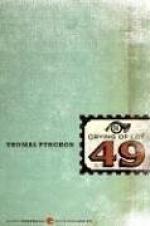|
This section contains 7,231 words (approx. 25 pages at 300 words per page) |

|
SOURCE: "The Postmodern Labyrinths of Lot 49," in Critique: Studies in Contemporary Fiction, Vol. XXXIV, No. 2, Winter, 1993, pp. 83-99.
In the following essay, Gleason examines the postmodern attributes and "labyrinthine" structure of The Crying of Lot 49, particularly as found in the novel's indeterminate language, puns, "symbolic landscape, narrative design, and sexual dynamics."
[M]an now lives in a circle without a center, or in a maze without a way out.
—Edward Said, "Abecedarium Culturae: Structuralism, Absence, Writing"
Said's twinned metaphors concisely, if somewhat sexistly, limn recognizable features of contemporary society and employ terms that appear more and more frequently in our literary, critical, and social discourses. Wendy Faris's recently published Labyrinths of Language, for example, focuses on Said's latter possibility; the book attempts to illustrate "the central place of the labyrinth in the modern western [literary] tradition." Faris traces the labyrinth as both textual symbol and narrative structure through...
|
This section contains 7,231 words (approx. 25 pages at 300 words per page) |

|


